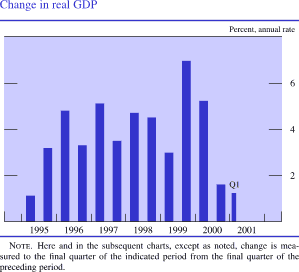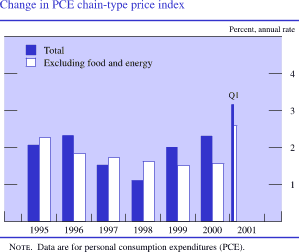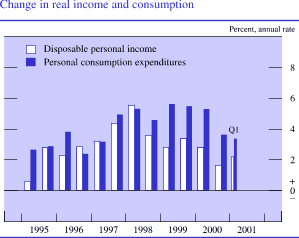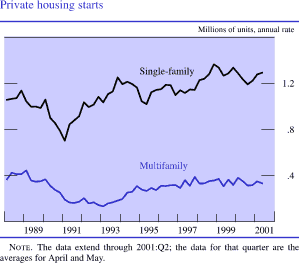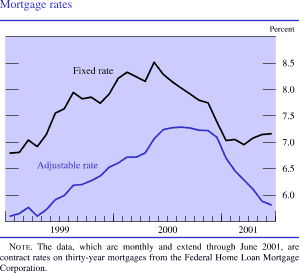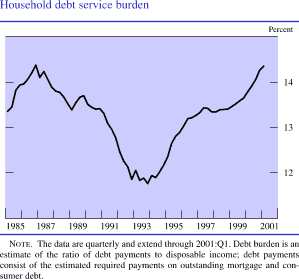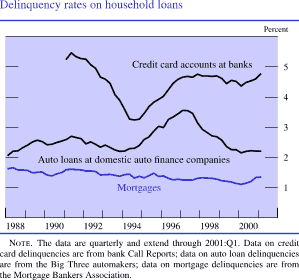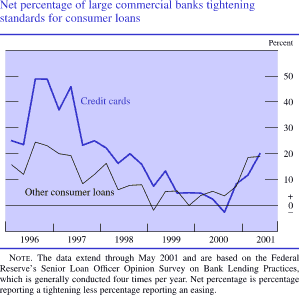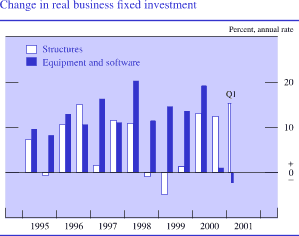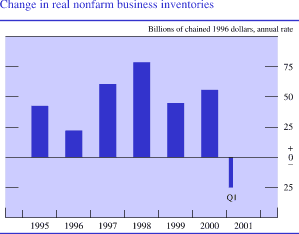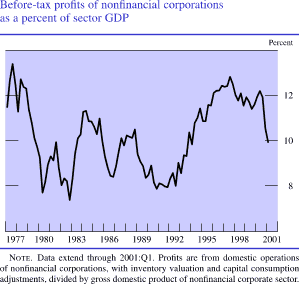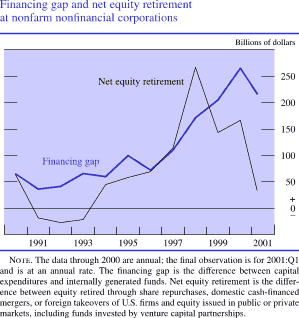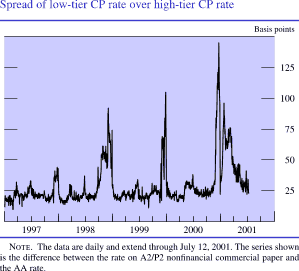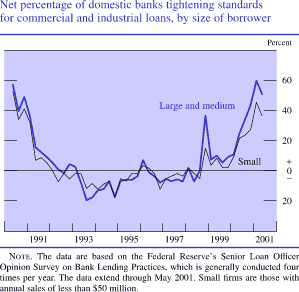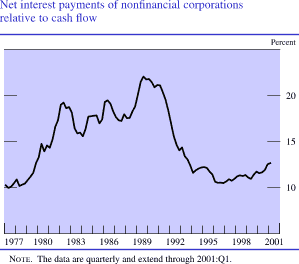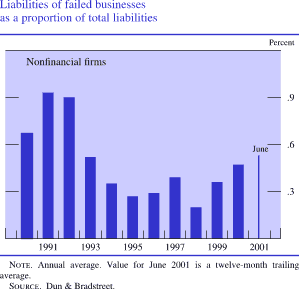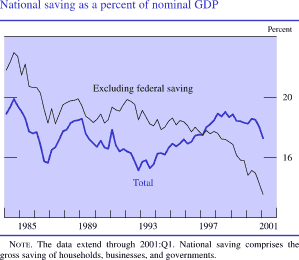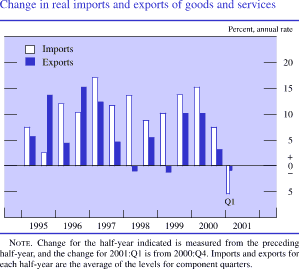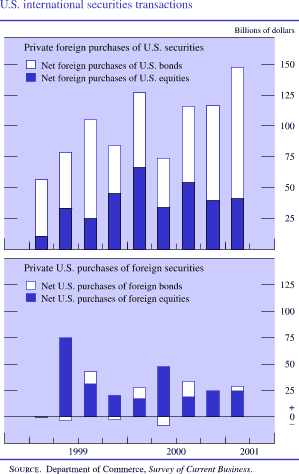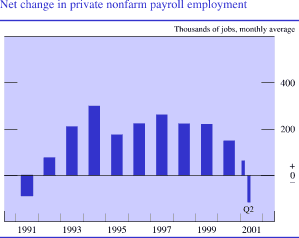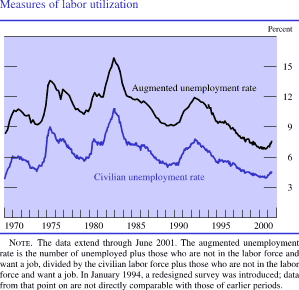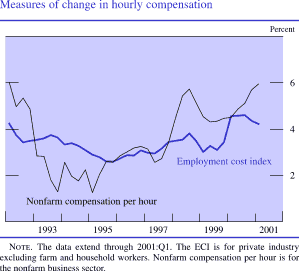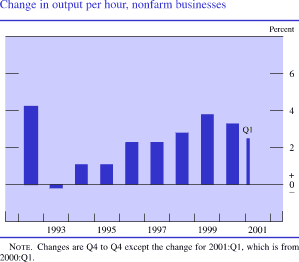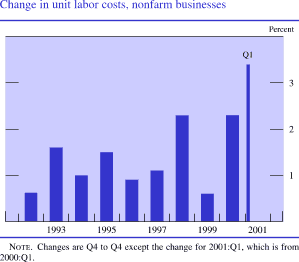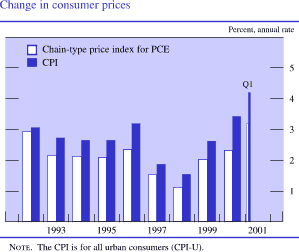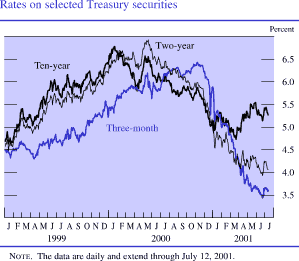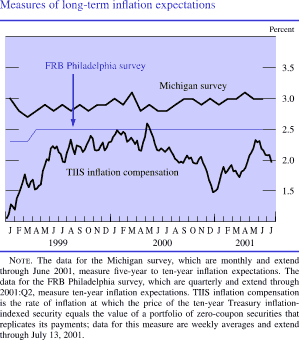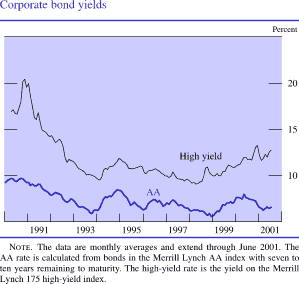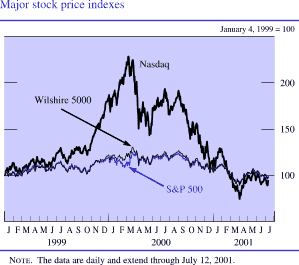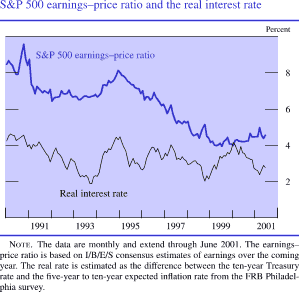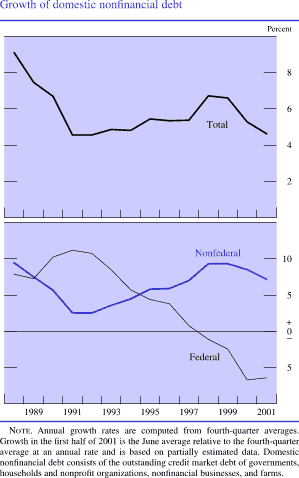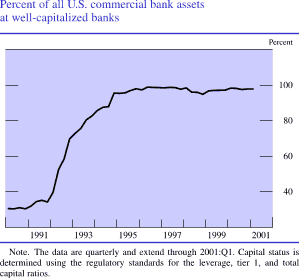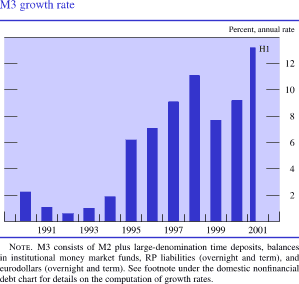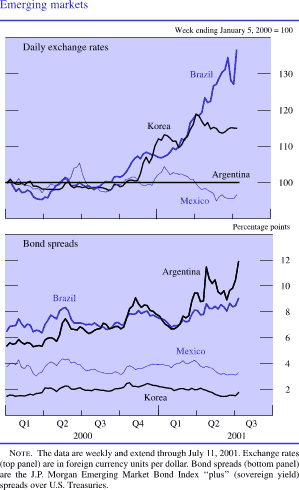|
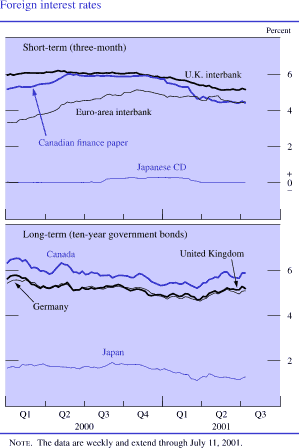
Slower U.S. growth, monetary easing by the
Federal Reserve, fluctuations in U.S. stock prices, and the large U.S.
external deficit have not undermined dollar strength. After the
December 2000 FOMC meeting, the dollar lost ground against the major
currencies; but shortly after the FOMC's surprise rate cut on
January 3, the dollar reversed all of that decline as market
participants evidently reassessed the prospects for recovery in the
United States versus that in our major trading partners. The
dollar as measured by a trade-weighted index against the currencies of
major industrial countries gained in value steadily in the first
three months of 2001, reaching a fifteen-year high in late March.
Continued flows of foreign funds into U.S. assets appeared to be
contributing importantly to the dollar's increase. Market reaction to
indications that the U.S. economy might be headed toward a more
prolonged slowdown undercut the dollar's strength somewhat in early
April, and the dollar eased further after the unexpected April 18 rate
cut by the FOMC. However, the dollar has more than made up that loss in
recent months as signs of weakness abroad have emerged more
clearly. On balance, the dollar is up about 7 percent
against the major currencies so far this year; against a broader index
that includes currencies of other important trading partners, the
dollar has appreciated 5 percent.
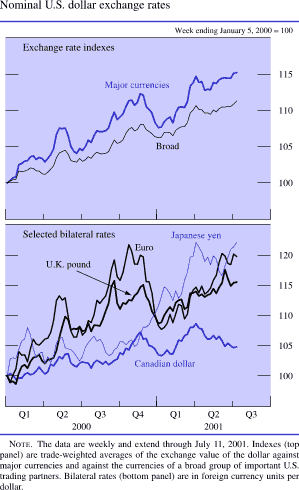
The dollar has gained about 9 percent against the
yen, on balance, as the Japanese economy has remained troubled by
structural problems, stagnant growth, and continuing deflation.
Industrial production has been falling, and real GDP declined slightly
in the first quarter, with both private consumption and investment
contracting. Japanese exports also have sagged because of slower demand
from many key trading partners. Early in the year, under increasing
pressure to respond to signs that their economy was weakening further,
the Bank of Japan (BOJ) slightly reduced the uncollateralized overnight
call rate, its key policy interest rate. By March, the low level of
equity prices, which had been declining since early 2000, was provoking
renewed concerns about the solvency of Japanese banks. In mid-March,
the BOJ announced that it was shifting from aiming at a particular
overnight rate to targeting balances that private financial
institutions hold at the Bank, effectively returning the overnight rate
to zero; the BOJ also announced that it would continue this easy
monetary stance until inflation moves up to zero or above. After the
yen had moved near the end of March to its weakest level relative to
the dollar in more than four years, Japanese financial markets were
buoyed by the surprise election in May of Junichiro Koizumi to party
leadership and thereby to prime minister. The yen firmed slightly for
several weeks thereafter, but continued weak economic fundamentals and
increased market focus on the daunting challenges facing the new
government helped push the yen back down and beyond its previous low
level.
At the start of 2001, economic activity in the euro area had
slowed noticeably from the more rapid rates seen early last year but
still was fairly robust. Average GDP growth of near 2 percent was
only slightly below estimated rates of potential growth, although some
key countries (notably Germany) were showing signs of faltering
further. Although high prices for oil and food had raised headline
inflation, the rate of change of core prices was below the 2 percent
ceiling for overall inflation set by the European Central Bank
(ECB). The euro also was showing some signs of strength, having moved
well off the low it had reached in October. However, negative
spillovers from the global slowdown started to become more evident in
weaker export performance in the first quarter, and leading indicators
such as business confidence slumped. Nevertheless, the ECB held policy
steady through April, as further weakening of the euro against the
dollar (following a trend seen since the FOMC's rate cut in early
January), growth of M3 in excess of the ECB's reference rate, and signs
of an edging up of euro-area core inflation were seen as militating
against an easing of policy.
In early May, the ECB surprised markets with a 25 basis
point reduction of its minimum bid rate and parallel reductions
of its marginal lending and deposit rates. In explaining the
step, the ECB noted that monetary developments no longer posed a threat
to price stability and projected that moderation of GDP growth would
damp upward price pressure. The euro has continued to fall since then
and, on balance, has declined 9 percent against the dollar since
the beginning of the year. Faced with a similar slowdown in the U.K.
economy that was exacerbated by the outbreak of foot-and-mouth disease,
the Bank of England also cut its official call rate three times (by a
total of 75 basis points) during the first half of the year. The
Labor Party's victory in parliamentary elections in early June seemed
to raise market expectations of an early U.K. euro referendum and put
additional downward pressure on sterling, but that was partly offset by
signs of stronger inflationary pressure. On balance, the pound has lost
about 6 percent against the dollar this year, while it has
strengthened against the euro.
The exchange value of the Canadian dollar has swung over a wide
range in 2001. In the first quarter, the Canadian dollar fell about
5 percent against the U.S. dollar as the Canadian economy
showed signs of continuing a deceleration of growth that had started in
late 2000. Exports--especially autos, auto equipment, and electronic
equipment--suffered from weaker U.S. demand. Softer global prices for
non-oil commodities also appeared to put downward pressure on the
Canadian currency. With inflation well within its target range, the
Bank of Canada cut its policy rate several times by a total of
125 basis points. So far this year, industries outside of
manufacturing and primary resources appear to have been much less
affected by external shocks, and domestic demand has maintained a
fairly healthy pace. Since the end of March, the Canadian dollar has
regained much of the ground it had lost earlier and is down about
2 percent on balance since the beginning of the year.
Global financial markets were rattled in February by serious
problems in the Turkish banking sector. Turkish interest rates soared
and, after market pressures led authorities to allow the Turkish lira
to float, it experienced a sharp depreciation of more than
30 percent. An IMF program announced in mid-May that will bring
$8 billion in support this year and require a number of banking and other
reforms helped steady the situation temporarily, but market sentiment
started to deteriorate again in early July.
In Argentina, the weak economy and the
government's large and growing debt burden stoked market fears that the
government would default on its debt and alter its one-for-one peg of
the peso to the dollar. In April, spreads on Argentina's
internationally traded bonds moved up sharply, and interest rates
spiked. In June, the government completed a nearly $30 billion
debt exchange with its major domestic and international creditors aimed
at alleviating the government's cash flow squeeze, improving its debt
amortization profile, and giving it time to enact fiscal reforms and
revive the economy. Argentine financial conditions improved somewhat
following agreement on the debt swap. However, this improvement proved
temporary, and an apparent intensification of market concerns about the
possibility of a debt default triggered a sharp fall in Argentine
financial asset prices at mid-July. This financial turbulence in
Argentina negatively affected financial markets in several other
emerging market economies. The turmoil in Argentina took a particular
toll on Brazil, where an energy crisis added to other problems that
have kept growth very slow since late last year. Intervention
purchases of the real by the Brazilian central bank and a
300 basis point increase in its main policy interest rate helped
take some pressure off the currency, but the real has
declined about 24 percent so far this year.
|

